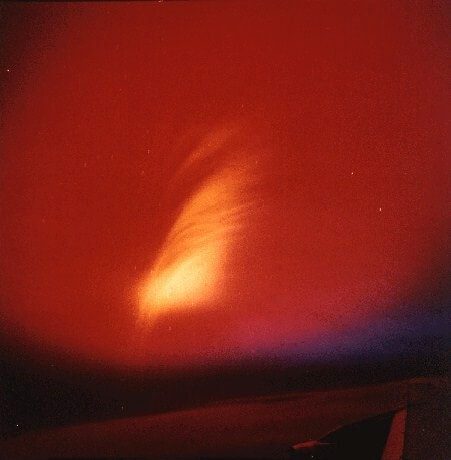A “troubling” space-based anti-satellite weapon is being developed by Russia, according to US intelligence.
The news was originally intended just for Congress but, at the request of Republicans, elements of such a threat were disclosed to the public. To allay some of the concerns, the White House added that there was no immediate threat. National security spokesman John Kirby added that, although US intelligence had reason to believe the technology had already been developed, the weapon was not currently operational.
Judging from the ensuing global media frenzy, prompted by the idea of Russia launching a nuclear weapon into space, the nuances were not reassuring. Russia’s President Vladimir Putin has categorically denied that his country has plans to put a nuclear anti-satellite weapon into space. Putin also categorically denied that Russia had plans to invade Ukraine before it did so.

Post explosion Starfish Prime nuclear test debris in upper atmosphere as imaged from an aircraft in July 1962. Courtesy: US Air Force
So why would a nation want to build a nuclear space weapon?
With few details revealed about the space weapon, it remains unclear if Russia plans to launch a nuclear weapon into orbit as a kind of continuous threat – an act that would be in breach of the international Outer Space Treaty (1967) – or to detonate it in the upper atmosphere.
The weapon might not be used as a direct nuclear bomb. Instead, it could be employed to destroy satellites utilising a focused X-ray laser type of beam, powered by a nuclear explosion. Research into a similar device took place in the US under Project Excalibur in the early 1980s as part of the ‘Star Wars’ research programme into nuclear missile and satellite interception systems.
The other use of such a nuclear demonstration would be as a warning signal by one nation to others to stop interference in its interests. In Russia’s case, it may be used as a warning shot ‘across the bows’ of NATO, should it appear to be on the verge of becoming directly involved in the Ukrainian conflict.
Nuclear weapons in space are not a new concept
Nuclear weapons have long been considered for use in space. Initial high-altitude weapons tests found that the electronic systems of satellites in orbit could be damaged by [CHECK] the electromagnetic pulse (EMP) from a nuclear explosion.
The US Starfish Prime nuclear weapon’s test over the Pacific on 9 July 1962 involved a 1.4 MT (megaton) explosion which could be seen from Hawaii. Its initial EMP even caused street lighting to fail on the ground, while the resulting beta particle radiation seriously damaged at least four of the 18 active satellites that were in LEO or elliptical orbits at the time. Satellites are better protected nowadays against radiation, nevertheless a specialist weapon producing a large EMP could destroy them.
Missile and ‘killer satellite’ interceptions of individual spacecraft in orbit have already been successfully achieved by the US, Russia, China and India. However, with thousands of spacecraft in orbit and more to come, this method of warfare in space is deemed impractical due to costs.
As such, there has been a resurgence of interest in using nuclear weapons to counter comsat constellations in LEO, such as Starlink or the GPS navigation constellation in medium Earth orbit (MEO). China is known to be examining the practicality of such a weapon. Similarly, North Korea has threatened to launch a ballistic missile that would carry a thermonuclear weapon (hydrogen bomb) for a test over the Pacific.
Meanwhile, British nuclear deterrents struggle to reach the air (and that’s on Earth)
Unhappily for the UK, its nuclear weapons programme also made headlines around the world after the unarmed test of a submarine missile failed in comic fashion on 30 January.
The news of Royal Navy Trident II D5 SLBM (Submarine Launched Ballistic Missile)’s launch failure marked a blow to the UK’s Trident nuclear deterrent – and to the US Navy’s own nuclear arsenal.
The missile, built by Lockheed Martin and taken from shared US and Royal Navy stock, would normally carry live nuclear warheads. During the test it pneumatically popped up above the surface of the sea after it was launched, as planned, from HMS Vanguard, a submerged submarine. However, its first-stage solid rocket motor then failed to ignite and the whole missile fell harmlessly back into the sea. The failure is the second in a row. The first, in 2016, involved a telemetry acquisition failure much later in the flight, which caused an automated termination.
The Sun newspaper, which revealed the scoop, reported that the UK Secretary of State for Defence, Grant Shapps, was aboard HMS Vanguard during the test. The UK abandoned its air-launched nuclear bomb/missile capability during the late 1990s to rely solely on Trident. Rather unconvincingly, Shapps noted that while there had been an anomaly to the missile, the test had “reaffirmed the effectiveness” of the UK’s nuclear deterrent.
Comment by David Todd: We don’t think so – this and the previous failure have sapped confidence in the deterrent. A successful test launch of another Trident missile, ideally as soon as possible, would rectify this.







